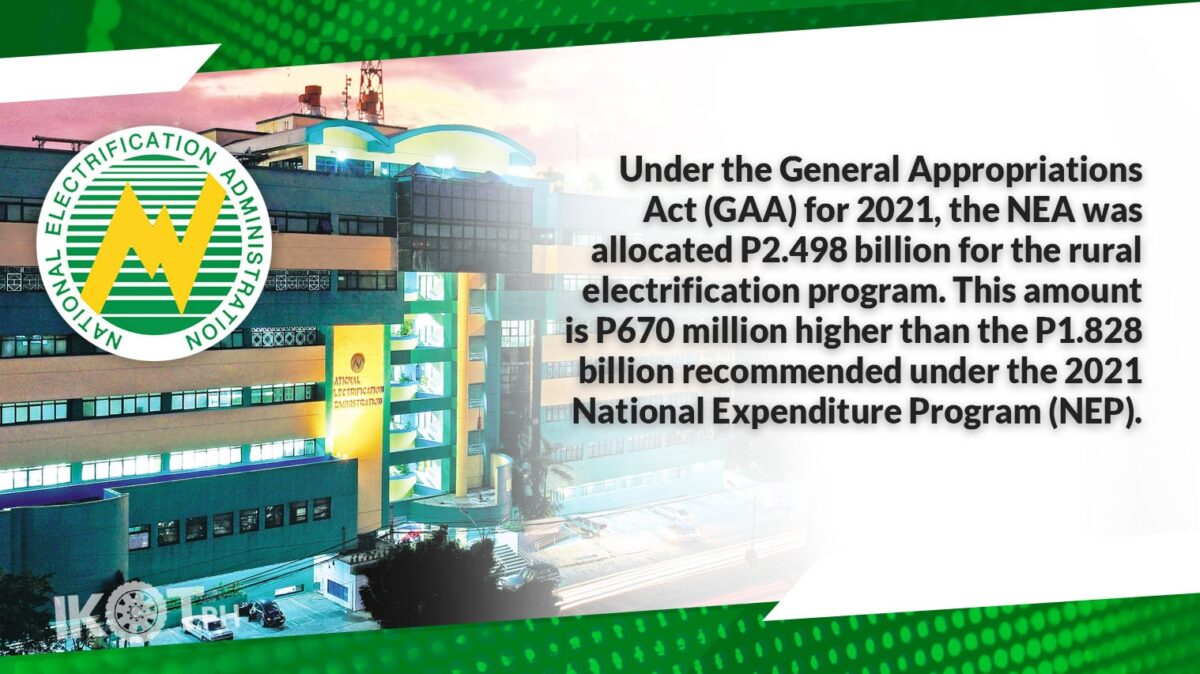State-run National Electrification Administration (NEA) welcomed the increase in funding for the implementation of the government’s rural electrification program for this year.
Under the General Appropriations Act (GAA) for 2021, the NEA was allocated P2.498 billion for the rural electrification program. This amount is P670 million higher than the P1.828 billion recommended under the 2021 National Expenditure Program (NEP).
The P2.498 billion is broken down as follows: PhP1.628 billion for the sitio electrification projects (SEP); P750 million for the Electric Cooperatives Emergency and Resiliency Fund (ECERF); P100 million for the installation of solar panels in schools in Lipa City, Batangas; and P20 million for the installation of solar panels in public schools.
“We are pleased to receive this additional allocation of P670 million to support the government’s rural electrification program, especially the emergency funds for the electric cooperatives (ECs) during calamities,” NEA Administrator Edgardo Masongsong said.
The P2.498 billion is broken down as follows: PhP1.628 billion for the sitio electrification projects (SEP); P750 million for the Electric Cooperatives Emergency and Resiliency Fund (ECERF); P100 million for the installation of solar panels in schools in Lipa City, Batangas; and P20 million for the installation of solar panels in public schools.
In the implementation of SEP, a special provision in the GAA states that the NEA shall “prioritize sitios where absolute number of indigents and the incidence of poverty are high as identified in the latest official poverty statistics of PSA as well as those with the high probability of being energized.”
The NEA shall also release funds only to ECs which have fully liquidated funds from previous years’ electrification projects. In cases where the ECs are not qualified to implement projects for barangay and sitio electrification, the NEA “may enter into a Memorandum of Agreement with the Department of Public Works and Highways, and the latter through its district engineering offices will implement the project.”
The release of SEP fund shall also be subject to the following: submission of National Unified Electrification Strategy as certified by the Department of Energy (DOE); submission of parameters for the selection of beneficiary sitios as certified by the DOE; and submission of a certification from the Barangay chairperson on the population and number of houses per sitio, map of the municipality or city indicating the sitios and barangays to be energized, and cost of energizing a sitio.
Under the 2021 NEP, the Department of Budget and Management (DBM) recommended P1.828 billion subsidy for the implementation of the rural electrification program, with P1.628 billion for SEP and P200 million for ECERF pursuant to Republic Act No. 11039, also known as the ECERF Act.
Under the 2021 NEP, the Department of Budget and Management (DBM) recommended P1.828 billion subsidy for the implementation of the rural electrification program, with P1.628 billion for SEP and P200 million for ECERF pursuant to Republic Act No. 11039, also known as the ECERF Act.
The ECERF Law, enacted in June 2018, seeks an orderly and continuing means of financial assistance to ECs in the form of grants for the immediate restoration or rehabilitation of damaged infrastructure after a fortuitous event or force majeure.

